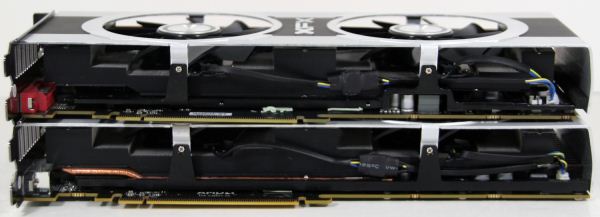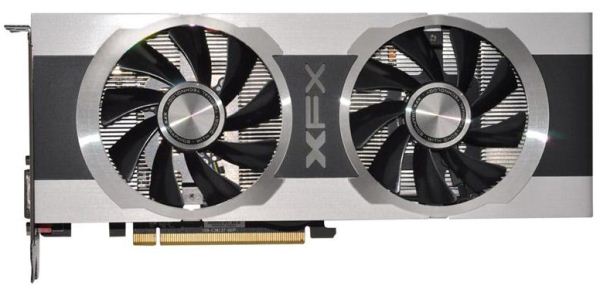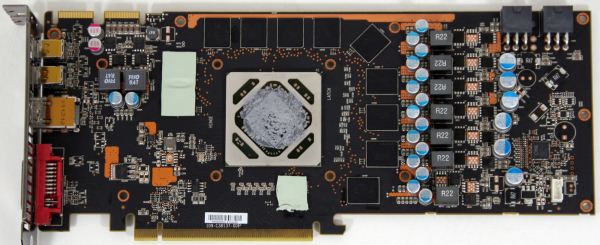AMD Radeon HD 7950 Review Feat. Sapphire & XFX: Sewing Up The High-End Market
by Ryan Smith on January 31, 2012 9:02 AM ESTMeet the XFX R7950 Black Edition Double Dissipation
Our second partner card of the day is XFX’s R7950 Black Edition Double Dissipation. Like the 7970 Black Edition Double Dissipation we reviewed earlier this month, the 7950 BEDD is a factory overclocked card (Black Edition) using XFX’s Double Dissipation cooler.
Starting with the overclock, XFX is shipping the 7950 BEDD with a core clock of 900MHz and a memory clock of 5.5GHz. This represents a 100MHz (12.5%) core clock overclock and 500MHz (10%) memory clock overclock, putting it just shy of the 925MHz core clock the 7970 ships at.
In terms of construction like all of the other 7950 cards launching today XFX is using AMD’s 7950 PCB. This means the PCB measures 10.25” long and features 2 6pin PCIe power sockets towards the rear of the card, while at the front the card uses the AMD standard port configuration of 1 DL-DVI, 1 HDMi, and 2 mini-DisplayPorts. The one notable deviation here from the Sapphire card is that XFX has not included a BIOS selection switch, so the card lacks any kind of ability to easily recover from a bad BIOS flash, and if unlocking proves viable it would not be a good candidate for the process.
Meanwhile cooling is provided by XFX’s Double Dissipation cooler. This is the same heatsink and fan assembly we saw with the 7970 BEDD, which makes this an open air cooler using a pair of fans to push air along an aluminum heatsink running almost the entire length of the card. Because it’s the same assembly, the shrouding for the card sticks out over the end of the PCB, negating the benefit of the shorter 7950 PCB and making the card 10.65” long just like the 7970 BEDD.

Top: 7950 BEDD. Bottom: 7970 BEDD
Do note that while it uses the same fan and heatsink assembly, Double Dissipation does not mean it uses the same vapor chamber assembly to transfer heat from the card. Where the 7970 BEDD used a fairly large vapor chamber, the 7950 BEDD uses a much smaller vapor chamber that only makes contact with roughly half of the heatsink, meaning that heat isn’t being transferred to the extremities of the heatsink nearly as well on the 7950 BEDD. Furthermore the aluminum plate covering the RAM and MOSFETs is poorly sized, leaving parts of the RAM chips (and their thermal pads) exposed. We’ll see how this plays out when we get to our testing, but the 7950 BEDD is clearly not as well built as the 7970 BEDD.
Rounding out the package is the same collection of extras that we saw in the 7970 BEDD. Inside you’ll find the usual driver CD and quick start guide, along with a metal XFX case badge, a mid-length CrossFire bridge, and a passive HDMI to SL-DVI adaptor. All of this is packed in one of XFX’s pleasantly small boxes, which doesn’t use much more space than the card itself.
The MSRP on the 7950 BEDD is $499, $50 over the MSRP for a regular 7950 and making it one of the more expensive 7950s launching today. XFX is offering a base 2 year warranty on the 7950 BEDD, which can be extended to a lifetime warranty by registering the card within 30 days of purchasing it.












259 Comments
View All Comments
Finally - Monday, February 6, 2012 - link
"While the performance is impressive, the pricing is just ridiculous and leaves a bittter taste in the mouth."That's why you don't put your GPUs in the mouth and chew on them...
kallogan - Tuesday, January 31, 2012 - link
Lamest pricing policy ever. AMD has apparently decided to stop selling gpus. Fine.Love the undervolted/Oced Sapphire. Undervolting is my way of life.
mdlam - Tuesday, January 31, 2012 - link
Why do you post this nonsense on a 7900 discussion? Does anyone who owns a top tier video card give a rats behind about undervolting? No. That's why you spend 30 dollars and buy a hd6770.kallogan - Tuesday, January 31, 2012 - link
You must have been hurt in some ways by my comment cause you're being agressive kitty.Look at the power consumption and noise levels. The sapphire despite a 100mhz OC blows every other card.
You can't say it's useless.
Ryan1981 - Tuesday, January 31, 2012 - link
The website of sapphire is listing a stock clocked version of the 7950:http://www.sapphiretech.com/presentation/product/?...
Just thought I'd include it.
Ryan1981 - Tuesday, January 31, 2012 - link
Ok after closer examination, almost stock, 810 Mhz Core clock.poohbear - Tuesday, January 31, 2012 - link
can you please use resolutions that the avg user uses? whats thsi 1980x1200 nonsense? who games at that resolution? by far the most popular resolutions are 1650x1050 & 1920 x1080. why not just post figures for those instead of having us guessing?UMADBRO - Tuesday, January 31, 2012 - link
HERP!1920x1080 is 16:9, 1920x1200 is 16:10.
DERP!
Black Obsidian - Tuesday, January 31, 2012 - link
Not to mention that if you game at 1680x1050, you don't need a high-end card anyway, and so have no reason to care how they benchmark at your Cro-magnon resolution. If you get a real monitor (1920x1200 or higher), you can come back for the performance numbers already provided in the article.piroroadkill - Tuesday, January 31, 2012 - link
My machines basically all use 16:10 screens. I have two laptops with 15" 1920x1200 screens, my main monitor is a U2410.. 1920x1200..